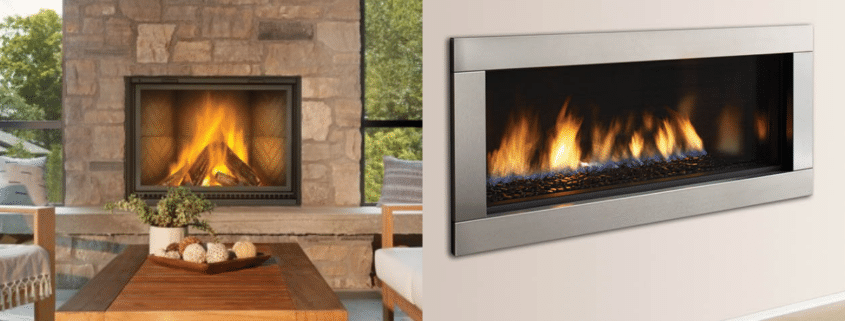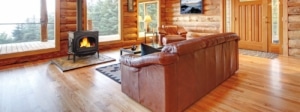Gas vs. Wood Fireplace: Which Is Right For You?
Perhaps you’d like to give your space a cozier aesthetic. Or, maybe you find peace in the idea of sitting next to a flame while you’re sipping your morning coffee. Maybe you’re tired of cold toes and noses, and you’d simply just like more heat in your home.
No matter the route you took to get here, you’ve made your decision; you’d like a fireplace. Your next step is to choose which type you want — gas or wood?
Below is our comparative breakdown of how these fireplaces types differ, the pros and cons of each, and how to determine which is best for you.
Gas vs. Wood Fireplaces: An Overview
While you likely already know the primary difference between gas and wood fireplaces, there are other characteristics that are important to understand as well. Let’s start with some basic definitions and examples of each.
Gas Fireplaces
Gas fireplaces operate using either natural gas or propane as fuel. A gas line connects to a residential source or propane tank and runs to the fireplace, which can be turned on either by a switch or a remote.
A few different types of gas fireplaces include gas inserts, gas stoves gas logs, and gas direct vents. You can read more about how these types differ in this blog.
At VanderWall Bros., we trust and supply gas fireplaces from these brands:
Photo courtesy of Regency® — Model: Regency® Energy™ E33 Gas Insert
Wood Fireplaces
Wood fireplaces operate using wood or wood-derived biomass products as fuel. They’re the most traditional type of fireplace and have been known to heat homes effectively for years.
Some types of wood-burning fireplaces include wood stoves, masonry fireboxes, factory-built fireboxes, and wood inserts. You can read how these types differ in this guide to fireplace terminology.
At VanderWall Bros., we trust and supply wood-burning fireplaces from the following manufacturers:
- Jøtul®
- HearthStone®
- Kozy Heat®
- Napoleon®
- earthcore Isokern
- Osburn
- Ironstrike®
- Vermont Castings™
- Majestic
- Spartherm®
- JC Bordelet
- European Home – Focus
Photo courtesy of Jøtul® — Model: F 500 V3 Oslo CF Wood Stove
Gas vs. Wood Fireplace: Which Is Best For Your Space?
There are several differentiating factors between gas and wood fireplaces, but we’ll be the first to say that there isn’t a “right” or “wrong” choice here. It just depends on which is best for you.
When deciding between a gas and wood fireplace, you’ll want to take a few things into consideration: you, your home or property, your lifestyle, your design goals, etc. From there, you’ll get a better understanding of which type can best suit your wants and needs.
TL;DR – Gas vs. Wood Fireplaces
|
Gas Fireplace |
Wood Fireplace |
| Heat output varies based on the type of gas fireplace, size of heated area, and fireplace efficiency | Heat output varies based on the type of gas fireplace, size of heated area, and fireplace efficiency |
| Cleaner, less sensory experience | Full sensory experience (sights, sounds, smells) |
| Releases fewer pollutants | Releases CO2 (but is limited by EPA emission requirements) |
| Very convenient and easy to use | Requires a lot of effort to obtain wood and build fires |
| Safer to run with less supervision | Requires more supervision while burning |
| Requires annual cleaning and inspection | Requires annual cleaning and inspection, plus more day-to-day maintenance and chimney sweep services |
| Upfront cost varies; operating costs subject to natural gas and propane price fluctuations | Upfront cost varies; operating costs more are stable if you have a reliable wood supplier |
Gas vs. Wood Fireplace Heat Output
When it comes to heat output, both gas and wood fireplaces vary tremendously. Heat output is typically measured in British Thermal Units (BTUs), but those numbers alone aren’t enough to tell how well a fireplace will heat your space.
The right amount of heat output can vary based on the product you choose and how much living area you intend to heat. Your fireplace needs to be properly sized, and you also need to consider efficiency. A fireplace can have tremendous heat output but be very inefficient.
Once you’ve determined the size of the heated area, a fireplace expert can help you determine how many BTUs and what efficiency rating to shoot for.
Gas vs. Wood Fireplace Sensory Experience
Gas fireplaces are “cleaner” — both in terms of physical mess and sensory experience. They don’t present wood chips, crackling noises, burning smells, etc. However, they can still look just as warm and inviting.
Wood fireplaces are the real deal when it comes to sensory experience. They offer an ambiance of satisfying crackles and smoky scents, which many homeowners and fireplace lovers find cozy and relaxing. If you’re looking for the full effect of a wood-burning fire, no other fireplace option can bring you these features.
Gas vs. Wood Fireplace Environmental Impact
Both gas and wood fireplaces score certain points for environmental impact — it just depends on what type of impact you’re looking at.
Gas fireplaces don’t emit smoke or gasses, so they release fewer pollutants into the atmosphere. However, we’ve recently experienced some uncertainty with these fuels in terms of cost and availability.
Wood fireplaces release CO2, among other gasses, into the atmosphere. However, the Environmental Protection Agency (EPA) provided new lower emission requirements for wood-burning units back in May 2020. Also, wood is a renewable resource that you can rely on to be relatively available and affordable. Wood stoves in particular are known to be highly efficient and low-impact. There’s even a valuable biomass stove tax credit available to anyone who purchases and installs one.
Gas vs. Wood Fireplace Convenience
Gas fireplaces are incredibly easy to operate. You can turn them on and off by simply pressing a remote button or flicking a switch. They’re a great option for anyone who desires cozy fires but doesn’t want to deal with the hassle of building and maintaining them.
Wood fireplaces require more effort — often a lot more effort. Some wood-burning fireplace owners even describe owning one as a “lifestyle.” You need to gather, maybe chop, stack, store, and move the wood. Then, you actually need to build and kindle the fire each time. If you’re not up for those tasks, a wood fireplace may not be the right choice for you.
Gas vs. Wood Fireplace Safety
When installed, operated, and taken care of properly, both options are inherently safe. The difference in safety mostly relies on how you supervise the fireplace, and those around it, while it’s in use.
Gas fireplaces are typically safer to run with less supervision. They bring outside air into a sealed combustion chamber, operating behind closed glass doors. They can easily be turned off with the flick of a switch or punch of a button. Plus, gas fireplaces are able to be installed into more spaces due to ease of venting.
Wood fireplaces require a bit more supervision. While the fire can burn behind closed doors or a gate, it could also be an open, exposed flame. Sparks may fly, and logs may crumble or crash. They also can’t be put out quite as easily. For these reasons, there are very specific requirements with where and how wood-burning fireplaces can be installed. These are also important things to keep in mind if you have pets or small children that you would need to supervise closely while a fire is burning.
Gas vs. Wood Fireplace Maintenance & Cleaning
Most manufacturers recommend that gas and wood fireplaces be inspected and cleaned annually. This ensures they’re in good condition, safe, and operating at maximum efficiency.
In terms of day-to-day maintenance, however, wood fireplaces typically require more. Wood comes with chips, dirt, and ashes to take care of, so you may need to clean your wood fireplace more often than once per year. You will also need to get chimney sweep services (to clean out chimney flue or buildup of creosote) at least once per year.
Gas vs. Wood Fireplace Cost
The cost of gas and wood fireplaces varies based on what type and brand you get and who installs it. It’s difficult to pinpoint which is more or less expensive upfront.
Operating costs can vary too. Fluctuating natural gas and propane prices have made gas fireplaces more expensive to run compared to previous years. However, they’re still a feasibly affordable option for many homeowners.
In some circumstances, wood may be a safer bet because it’s a renewable resource that will always be available and isn’t quite as subjected to drastic fluctuations. However, finding a good, reliable source of wood can be a bit difficult if you don’t already know someone. Do you need a few ricks or cords? Will your supplier deliver, and will they deliver to your property — whether that be in a rural area or a city? This is something many people fail to consider but can make all the difference.
Looking to Purchase a Gas or Wood Fireplace? Contact VanderWall Bros.
If you’ve got your mind set on a new fireplace for your space, we’re your top-choice supplier. At VanderWall Bros., we carry amazing selections of both gas and wood fireplaces — all from trusted manufacturers.
From helping you pick the right fireplace to installing it within an artfully designed mantel, we’re here with you every step of the way. Give our team a call or contact us online to start your project.










